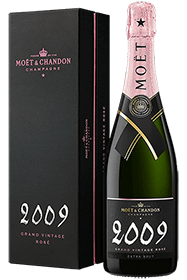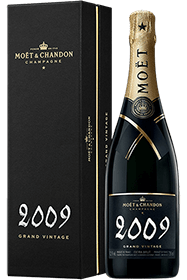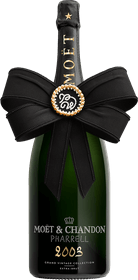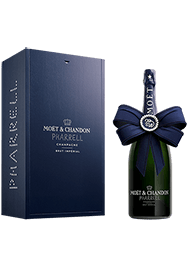Moët & Chandon owns the largest vineyard in the Champagne region. The majority of its terroirs are classified as crus, grands crus and premiers crus, allowing the production of very high quality wines. The name Moët & Chandon is known throughout the world: the House has anchored its reputation in France and internationally since its creation.
Moët & Chandon: the most famous Champagne estate
The Moët & Chandon Champagne House was founded in 1743 by Claude Moët, a visionary wine merchant, who quickly made its name among the European courts. A few years later his grandson, Jean-Rémy Moët, developed the House's international reputation.
Jean-Rémy Moët created the House's emblematic cuvée, Moët Imperial, in honour of the Emperor Napoleon Bonaparte, who visited the estate several times and is said to have invented with his troops the gesture of sabering bottles of Moët & Chandon champagne to celebrate a victory.
Several festive traditions were born thanks to the brand. The German emperor William II launched his yacht with Moët & Chandon Brut Impérial, starting the tradition. The pyramid of flutes and the rain of celebrationary champagne at car race victories is done with Moët et Chandon.
Owned by the LVMH group since 1987, the house develops unique cuvées from a meticulous selection of Champagne terroirs that are world renowned for their quality and enchanting character.
The magnum: a bottle for big, festive moments
Large bottles represent festivity, abundance and extravagance. A magnum of champagne is the symbol of celebrating special occasions in a big group. Moët & Chandon magnums are served to celebrate birthdays, weddings, sporting victories and any kind of success.
How many flutes are there in a magnum?
The capacity of a magnum is 1.5 litres, equivalent to 2 bottles of 75 cl. A flute of champagne contains 12.5 cl, so 12 glasses can be served with a magnum. This large format will delight between 6 and 12 guests.
Champagne in magnum ages better than in 75cl bottles
Magnums are formats that allow wines to increase their ageing capacity because they undergo less oxygenation. Proportionally, there is less air in a magnum than in a 75cl bottle. If the champagne is in contact with less oxygen, then it will oxidise less quickly. Other factors slow down the ageing process, such as thermal inertia. Temperature differences deteriorate the wine and make it age faster, but in a large container it is better protected as it takes longer to or gain degrees. If a wine in a large container evolves less quickly, it will keep its early sensory qualities longer, in other words its primary scents (fruit, flowers, plant), a good acidity and its tannins still present.
The origin of the magnum format
The name magnum is of Latin origin meaning "large." It was the English who created the first glass bottles to hold wine in the 17th century ; the magnum format was invented a century later. The British, importing Port and Bordeaux wine, established the units of measurement for wine containers: a 225 litre barrel was 50 imperial gallons, or 300 bottles of 0.75 cl. A gallon was equivalent to 4.5 litres or a case of wine of 6 bottles of 0.75 cl. Since 1866, the official size of a wine bottle is 0.75 cl. The magnum therefore contains twice the classic size, i.e. 1.5 litres.
Four emblematic champagnes from Moët et Chandon in a large format
The champagne House puts its emblematic white and rosé cuvées in large bottles in brut and demi-sec dosage. Discover these four cuvées in a box of 3 magnums.
Moët et Chandon Brut impérial
Moët et Chandon's Brut Impérial has a gourmet blend made up mostly Pinot Noir and Pinot Meunier. The amount of Chardonnay is limited. The grapes used to make this Moët et Chandon Brut Champagne come from an excellent terroir of over 200 crus. In order to give it its unique character, 20 to 30% of reserve wines are added, boosting its complexity.
Moët & Chandon Grand Vintage 2012
Eminent years deserve special attention, which is why Moët et Chandon has created vintage cuvées. These champagnes are unique and made exclusively with that year’s wines. The 2012 vintage has a striking maturity: its blend has an atypical style, it is made mostly with Chardonnay, producing scents of pear and white flowers and a refreshing vivacity.
Moët & Chandon Ice Impérial
Cuvée Ice Impérial, designed to be enjoyed on the rocks, is dosed with 45 grams of sugar per litre. The blend respects the style of the House, with a majority of red grape varieties used. They represent between 80 and 90% and the rest is composed of Chardonnay. This wine reveals a balance between an aromatic intensity, a beautiful roundness and an acidity that brings a touch of freshness.
Moët & Chandon Ice Impérial Rosé
Moët et Chandon's rosé champagnes are extravagant thanks to their warm colour. The Ice Impérial Rosé has been specially created to be tasted on the rocks. Its dosage is 45 grams of sugar per litre, classifying it as a demi-sec champagne. This wine retains the same characteristics as the classic cuvées of the House, with a higher proportion of Pinot Noir and Pinot Meunier. It is intensely fruity, with notes of strawberries, raspberries and redcurrants, vivacious and fresh with menthol scents.
The large formats of Moët et Chandon
The magnum is one of the most popular bottles for festive moments, but it has competition, such as the Moët et Chandon Jeroboam (3 litres), the Methuselah (6 litres), the Salmanazar (9 litres) and the Nebuchadnezzar (15 litres). These large sizes are the symbol of splendour, abundance and extravagance. They elevate a moment shared and a convivial atmosphere to the next level.











